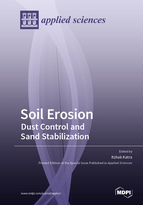Soil Erosion: Dust Control and Sand Stabilization
A special issue of Applied Sciences (ISSN 2076-3417). This special issue belongs to the section "Earth Sciences".
Deadline for manuscript submissions: closed (30 June 2020) | Viewed by 29816
Special Issue Editor
Interests: geomorphology; soil erosion; aeolian processes; dust sources and emissions; arid soils under human activities; sand transport and land formation; boundary-layer wind tunnel experiments; dust storms and air pollution
Special Issues, Collections and Topics in MDPI journals
Special Issue Information
Dear Colleagues,
Soil erosion by wind is significant to the Earth systems and the quality of human life. Climate change of drier conditions is associated with desertification and, thus, increased dust emission from soils and sand-dune transport. Moreover, many soils throughout the world are subjected to the impacts of rapid population growth and extensive land uses, including agricultural fields, grazing areas, unpaved roads, mines and quarries, waste soils, active sand dunes and sand sheets, and more. There is a strong interest in understanding the factors and processes of soil erosion by wind as well as in developing and applying methods to control dust emission from soils and to stabilize active sands. This Special Issue on soil erosion invites novel and original articles based on physical and chemical theories, field and laboratory experimental, soil analyses, and/or statistical and mathematical modeling that advance our knowledge on dust control and sand stabilization.
Topics of interest include, but are not limited to:
- Applications of natural and synthetic materials to reduce dust emission;
- Development of materials and methods for dust control and sand stabilization;
- Distribution of atmospheric particulate matter (PM) from dust sources;
- Integration of experimental methods and modeling in dust emission;
- Impacts of dust control applications on the soil quality and the environments;
- Quantification of the efficiency in dust control and sand stabilization applications.
Prof. Itzhak Katra
Guest Editor
Manuscript Submission Information
Manuscripts should be submitted online at www.mdpi.com by registering and logging in to this website. Once you are registered, click here to go to the submission form. Manuscripts can be submitted until the deadline. All submissions that pass pre-check are peer-reviewed. Accepted papers will be published continuously in the journal (as soon as accepted) and will be listed together on the special issue website. Research articles, review articles as well as short communications are invited. For planned papers, a title and short abstract (about 100 words) can be sent to the Editorial Office for announcement on this website.
Submitted manuscripts should not have been published previously, nor be under consideration for publication elsewhere (except conference proceedings papers). All manuscripts are thoroughly refereed through a single-blind peer-review process. A guide for authors and other relevant information for submission of manuscripts is available on the Instructions for Authors page. Applied Sciences is an international peer-reviewed open access semimonthly journal published by MDPI.
Please visit the Instructions for Authors page before submitting a manuscript. The Article Processing Charge (APC) for publication in this open access journal is 2400 CHF (Swiss Francs). Submitted papers should be well formatted and use good English. Authors may use MDPI's English editing service prior to publication or during author revisions.
Keywords
- Aeolian processes
- Arid areas
- Dust emission
- Dust sources
- Environamtal pollution
- Infrastructures
- Human activities
- Particle size distribution
- Polymers
- Sand dune
- Sand transport
- Soil erosion
- Soil physics
- Soil quality
- Topsoil






